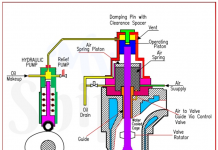
Q. Referring to the latest IMO “ Code on Noise Level onboard Ships”, define and explain the following terms:-
A). A- weighted equivalent sound level
B). C-weighted equivalent sound level
C). Sound pressure levels
D). Weighted sound reduction Index
Answer:-
Regulation II-1/3-12 of (SOLAS), 1974, as amended, adopted by resolution MSC.338(91), concerning protection against noise, provides that ships shall be constructed to reduce onboard noise and to protect personnel from noise in compliance with the Code on noise levels on board the ships. Required to establish mandatory noise level limits for the machinery spaces, control rooms, workshops, accommodation & other spaces on board ships. Code is in effect from 1st July 2014
- The Code is planned to provide standards to avert the occurrence of potentially hazardous noise levels on board the ships & to provide standards for an acceptable environment for the seafarers
- The Code is planned to provide the basis for a design standard, with compliance rely on the satisfactory conclusion of the sea trials that result in issuance of a Noise Survey Report.
- Ongoing operational compliance is predicated on the crew being trained in principles of the personal protection & maintenance of mitigation measures.
Requirements & recommendations in the code are made for:
1. Measurements of the noise levels & exposure;
2. Saving the seafarer from the risk of the noise-induced hearing loss under conditions where at present it is not practicable to limit the noise to a level which is not potentially harmful;
3. Limits on the acceptable maximum noise levels for all spaces to which seafarers generally have access; &
4. Verification of the acoustic insulation between the accommodation spaces.
A). A-WEIGHTED EQUIVALENT SOUND LEVEL
- A-weighted sound pressure level of the continuous steady sound that, within a calculated time interval, T, has the same mean square sound pressure as a sound under consideration which varies with the time.
- It is expressed in decibels A (dB(A)) & is given by the following equation:
- A-weighted sound pressure level or the noise level: The quantity calculated by the sound level meter in which the frequency response is weighted according to the A-weighting curve
- A-weighted is used to calculate the average noise level
- The human ear does not respond to all the frequency equally
- A-weighted follows the frequency sensitivity of human error at low levels & it also estimate quite well the damage risk of ear
B). C-WEIGHTED EQUIVALENT SOUND LEVEL
C-weighted sound pressure level of the continuous steady sound that within a calculated time interval, T, has the same mean square sound pressure as a sound under consideration which varies with the time.
It is expressed in decibels C (dB(C)) & is given by the following equation

C-weighted peak sound level LCpeak: C-weighted maximum instantaneous sound pressure level. It is expressed in decibels C (dB(C)) & is given by the following equation

- C-weighted sound pressure level or noise level: The quantity calculated by a sound level meter in which the frequency response is weighted according to the C-weighting curve
- C-weighted is used to calculate peak, impact or explosive noise
- Is accepted to represent the response of the human ear to peak sound pressure levels
- Is quite flat & includes much more of low frequency sound than A-weighted
C. SOUND PRESSURE LEVELS
Sound pressure level expressed in decibel (dB), of a sound or noise given by the following equation

- Sound pressure level (SPL) or acoustic pressure level is a logarithmic measure of the effective pressure of the sound relative to the reference value.
- The reference point is generally that of the threshold of hearing which has been agreed upon as having a value of 20μPa
- Is measured with a sound level meter weighted according to the specific frequency response
- Sound is measured with change in the air pressure. Larger the sound, larger the sound pressure
D. WEIGHTED SOUND REDUCTION INDEX
- Weighted sound reduction index, Rw: A single number value expressed in decibels (dB) which describes the overall sound insulation performance (in laboratory) of the walls, doors or floors provides
- It is a single number quantity which characterizes the air borne sound insulation of a material or the building element over a range of frequency
- The airborne sound reduction index for bulkhead & decks within accommodation shall comply with
- Cabin to cabin = 35
- Corridor to cabin = 30
- Mess room to cabin = 45
- Care should be taken in construction & erection of materials of the accommodation space
- Is used to measure the level of the sound insulation provided by the structure



